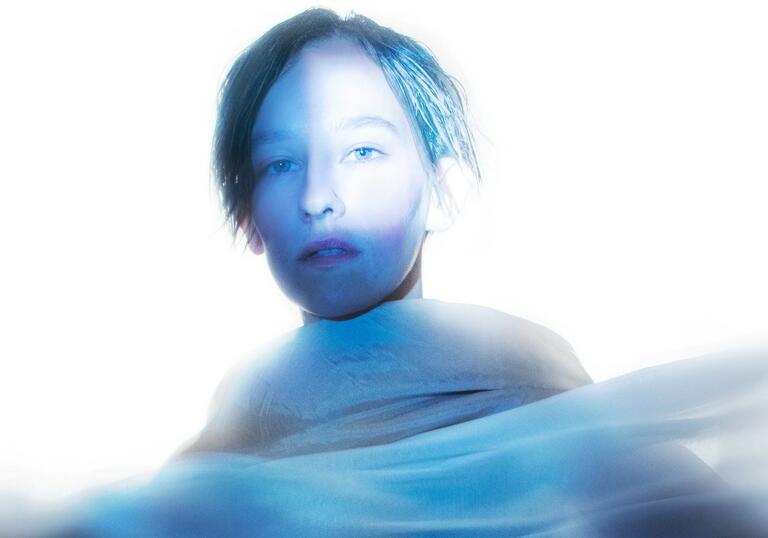Caterina Barbieri + Nexcyia - Digital Programme

Caterina Barbieri's Spirit Exit, which she performs at the Centre on Wednesday 26th October, is an album spawned by the restrictions and possibilities afforded by the pandemic. On the one hand, Barbieri was trapped in an apartment in Milan, requiring a pass from the authorities to travel more than a few streets away. On the other, being unable to tour opened up time and space to immerse herself fully in the creation of new music that has been described as 'a journey through inner-space as vast as a universe and as intimate as a heartbeat'.
Reviews of Barbieri's work frequently refer to that which is monumental or cosmic in scale: her music is like supernovae; like collapsing stars; like ascensions into the heavens. It's this that makes her live performances so exhilarating, and which creates a compelling counterpoint to the physical conditions under which Spirit Exit was made. The album artwork references this escape and surrender too: on the album cover, Barbieri is suspended, her pose a reference to the sculpture The Ecstasy of Saint Teresa.
The analogue synth and vocal compositions on Spirit Exit draw on minimalist foundations to construct kaleidoscopic geometries of polyphonic and polyrhythmic patterns. She renders evocations of the choral from beyond a digital threshold, in unfurling mandalas and cosmic architectures that are constantly in motion. Vocals form a large part of this album, amplifying the sense by which her music admits and alludes to notions of the sacred, perhaps as a paean to the ecstatic mysteries of signal processing: 'I’ve always worked with vocals to some degree, even in my very first release – Vertical, an album for Buchla 200 and voice,' she says. 'But it took me a long time to fully accept and embrace the vulnerability that comes with the use of your own voice.
'I like how synthesizers can distillate emotions into something 'other' or 'alien',' she continues, 'bypassing the intrinsically personal, vulnerable element of the human voice. At the same time, vocals are a way to inject more human energy into the pretty algid, machinic aspect of my work with technology. In Spirit Exit, I tried to find a balance in the human-machine ratio, to approach my voice as an extension of my modular synthesizer.'
She has described the way she worked at that time as 'ascetic', but it also offered the chance to create a sonic environment that was outside of the horror of the unfolding crisis, and in this way, the flights of sound she creates are a form of escape and resistance to lockdowns and crisis. 'Music can train your ability to be present in the moment, especially through deep listening,' she said. 'I think through this album, this took almost an existential meaning because I was so confined and so isolated – for me, music became a way to travel and move in space and time when movement was not possible at all.'
Spirit Exit was also written alongside a powerful female company of saints, philosophers and poets she was reading at the time, including St. Teresa D’Avila’s 16th century mystical text The Interior Castle, the posthuman theories of contemporary philosopher Rosi Braidotti, and the metaphysical poetry of Emily Dickinson. In an interview with the Barbican’s guide editor James Drury, she recently revealed that: 'These female thinkers, artists, poets, often they couldn’t really move in the outside world freely. And I think this state of confinement really triggered visionary thinking because they had to redirect their energy towards their works, because they couldn’t freely release them into the outside world.'
Released on her own label light-years, Spirit Exit follows last years' Fantas Variations, an album of reworks by eight collaborators of the first track on her 2019 album, Ecstatic Computation. Her debut album Patterns of Consciousness was released in 2017, followed by Born Again In The Voltage in 2018. She has also self-released a number of EPs through her own label along with collaborations on split releases and tracks with musicians including Lyra Pramuk, Kali Malone and Ellen Arkbro. She originally trained as a classical guitar player, albeit with a taste for heavy experimental music by artists including Corrupted and Keiji Haino, as well as the early music she was studying. Her move into working with synthesisers came through a residency at Stockholm's EMS studios in 2013. 'I'm interested in creating a hybrid creative environment,' she explains, 'where voice and synthesis dialogue and interconnect on a deep, structural level.'
On Spirit Exit, there is an intractable connection between the literal restricted spaces of its creation, and the expanses of time it opened. It's this duality that fuels the album's profound power to transcend a conscious instant; to expand time and transport us to a different sonic plane, where we can escape the everyday through surrender to the enveloping weight and ecstatic potential of Barbieri's immersive analogue electronic soundworlds.
Details
Hall
Location
The Barbican Hall is located within the main Barbican building. Head to Level G and follow the signs to find your seating level.
Address
Barbican Centre
Silk Street, London
EC2Y 8DS
Public transport
The Barbican is widely accessible by bus, tube, train and by foot or bicycle. Plan your journey and find more route information in ‘Your Visit’ or book your car parking space in advance.
We’ve plenty of places for you to relax and replenish, from coffee and cake to wood-fired pizzas and full pre-theatre menus
Mobility
Spaces for wheelchair users in row U at the rear of the stalls (up to sixteen, depth of row 180cm) and the back row of the circle (four), both with fold-down companion seats. Some seats in row S of the stalls for people with very limited mobility.
Assistance dogs
Assistance dogs may be taken into the concert hall where there are a limited number of suitable seats in row G of the stalls. If you prefer, you may leave your dog with a member of the cloakroom staff during the performance.
Hearing facility
There is an induction loop in the concert hall. You can use this by adjusting your hearing aid to the ‘T’ setting.
Free large-print programmes
These are available for most of our concerts. Please contact [email protected] at least a week beforehand, to prebook a large-print programmme.
For more access information, please visit our Accessibility section.





